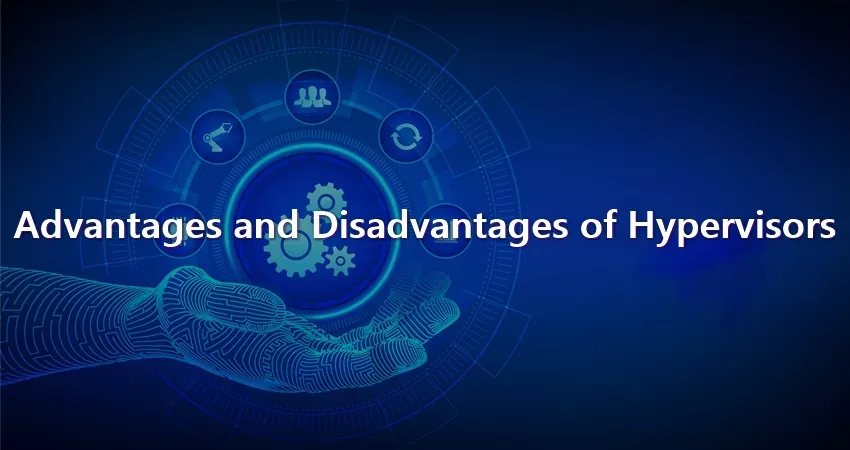Before jumping into the pros and cons of the hypervisor, here is a 101 on how it works:
The hypervisor is a software layer, firmware or hardware that creates and then runs multiple virtual machines.
Driven by the virtualization concept, a hypervisor basically splits one computer into distinct secure environments and appropriately distributes the physical computer’s resources between them.
Host – A computer or the physical hardware.
Guest – A virtual machine (VM) that uses the host’s resource pool (available processing power, storage, and memory resources).
A hypervisor is also known as the VMM (Virtual Machine Monitor), as it supports a single host to run and manage the execution of multiple guests concurrently.
Hypervisor’s working furthermore depends upon its category –
- Bare Metal hypervisor
– runs on the hardware directly. - Hosted hypervisor
– runs as a layer of software on an OS.
Characteristics of Hypervisors
Some of the most important characteristics of hypervisors are:
- Hypervisors allow users to create multiple isolated virtual instances on one single machine.
- Users can easily use hypervisor server resources dynamically between the virtual instances.
- A hypervisor easily captures the virtual machine’s system configuration and system state at a fixed time.
- Users can switch a virtual instance to another physical host without interrupting the current process or causing downtime.
Check Out:
In-Depth Differentiation of the Two Types of Hypervisor
An Overview of Hypervisor Vulnerabilities
Exploring the Advantages and Disadvantages of Hypervisor
Pros of Hypervisor
With a hypervisor, you can successfully run and monitor concurrent virtual machines on a host. Without it, operating multiple applications on the same hardware often creates conflicts.
VMMs make co-existing on one system possible and consolidate workloads and multiple operating environments.
It furthermore abstracts and isolates different operating systems and applications from the underlying host, creating independence.
Hypervisor secures the operating environment from internal conflicts.
It makes sure to individualize every virtual machine, so the problem of one does not affect the others. This VM isolation ensures they continue to run at peak performance.
No more underutilized resources. It directly provides appropriate supply for a process via connected VMs. Also, it removes any dependency over physical OS and applications.
Without accessing host resources, hypervisors achieve a better level of computing performance, availability, and scalability.
VMM reduces time consumption in testing and run-time debugging. It moreover, automates the management processes, resulting in low operational expenses.
Once done with the setup and licensing costs, hypervisors improve IT throughput and expenditures.
It provides economic relaxation around the datacenter, OS backup, hardware servers and even cuts down on power usage, making it an overall cost-effective transition.
VMM offers better uptime faster deployment, reduced workload, and cost predictions for operational needs.
Cons of Hypervisor (with solutions)
It becomes challenging to find reliable hypervisor services for your particular enterprise needs within a budget. Though free and open-source hypervisors are available for the same.
Hypervisor lacks the capability of running VMs on domestic computers. As an alternative, there are many non-hypervisor virtualization technologies for that.
Security may become an issue. While robust, hypervisors may become an easy cyberattack target. Vulnerability increases because of the centralized system, the company network, server rooms, etc.
Although a low possibility, these functions could cause more intrusions and a possible denial-of-service attack. But you will find that in many modern hypervisor solutions now, security is being handled appropriately.
You can furthermore ensure overall protection by limiting the host management access, encryption, UEFI secure boot, and a suitable network security tool.
You may also take professional help to mitigate the specter and to patch (update, fix, or improve) hypervisor and its hosts timely.
The upfront cost is most likely to be high for the initial system hypervisor transition.
Also, not all systems or software are fit for virtualization. This might become an issue when your application vendor does not have the hypervisor support in it.
Conclusion:
Remember, the benefits and drawbacks of hypervisor depend upon the VMM type and vendor you opt for your businesses.
So, be careful while choosing a hypervisor as the user interface, overhead, support, and management system depends heavily upon the types of hypervisor you employ.
You May Also Like To Read:
10 Best Open Source Hypervisor
Hypervisor vs. Docker: What is the Difference between the Two?
Top 10 Cloud Workload Protection Platforms

